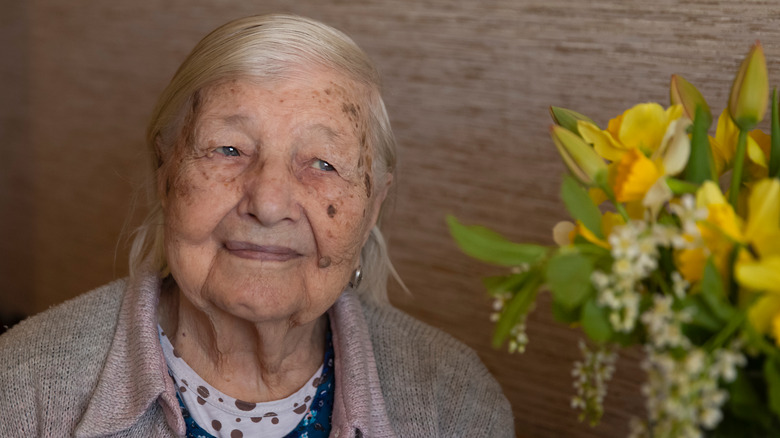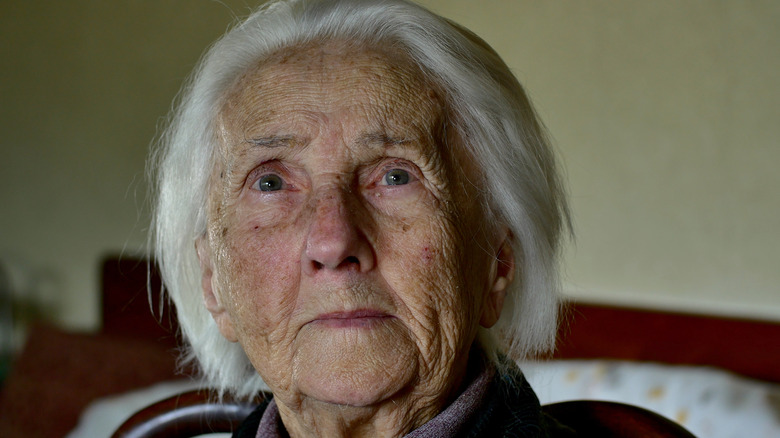The Ways You Are Most Likely To Die At Every Age In America
They say the only two things in the world you can be certain of are death and taxes, but death is the only thing that can actually excuse you from paying your taxes so, in a way, death is really the only thing you can be certain of.
You probably try not to spend a whole lot of time pondering the many ways you could shuffle off this mortal coil, because frankly, it's depressing and not really a super productive way to spend your time. That's okay though because the CDC and various other health authorities have already done all the math for you. Thanks, guys!
Depending on how many years you've already spent avoiding your ultimate reward (or punishment, no one's judging), the ways you are most likely to die do vary from year to year and decade to decade. The bad news is that knowing this information is less and less helpful the older you get — most causes of death are at least somewhat preventable, but the amount of control you have over the Grim Reaper's ultimate decision tends to decrease as the years go by. So consider the following information part public health service announcement, and part you're gonna die and you can't do anything about it. You're welcome.
Neonates
The first day of life is the most dangerous. No matter where you are in the world, your chances of dying at birth are ridiculously high compared to every other day of your life, and that's even true in the United States. Most people like to nurture the illusion that American health care is the best there is, but in 2013, Save the Children noted that 11,300 American babies die on the first day of life every year, which is more than anywhere else in the industrial world. In fact, there are about twice as many first-day deaths in America each year as there are in the entirety of Europe, and just in case you think that's a population thing, it isn't. Total annual births in Europe outnumber births in the United States by about 1 million.
According to the CDC, the leading causes of death for newborns here in the United States are (in order of how common they are) low birth weight, congenital defects, and maternal complications. Low birth weight is defined as any baby weighing less than 5 pounds, 8 ounces. A big cause of low birth weight is prematurity; obviously, when a baby is born early, it's less likely to be a healthy weight. But babies can also be born small because they stop growing before birth. Maternal health conditions like high blood pressure, diabetes, and infections can contribute to this, and so can drug use, both prescription and illicit.
Babies up to age 1
If you're lucky enough to survive the first day of life, you still have to get through your first year. As of 2019, infant mortality in the United States (defined as death that occurs any time before a child's first birthday) was 5.6 deaths per 1,000 births. Taken together, the three leading causes of death for babies under the age of one are birth defects, preterm birth, and injuries. Note, though, that the CDC includes newborn deaths in its numbers, so it's hard to say how the leading causes of death might change if you removed everyone who died during the first day of life.
Birth defects are tragically common. In the United States, the CDC reports that about one in every 33 babies is born with a birth defect. This includes more benign conditions like club foot and cleft lip and palate, but also a lot of dangerous conditions like major heart defects, spina bifida (a defect of the spine), and trisomy (chromosomal defects). Notably, the third leading cause of death in this age group is accidental injury (via the CDC), which includes suffocation. Suffocation deaths were once lumped under sudden infant death (that's the fourth leading cause of death in this group), but today we know many cases of sudden infant death are actually suffocation deaths. That's why it's important to put babies to sleep on their backs, remove sheets and pillows from cribs, and avoid falling asleep with your baby in your bed.
Kids ages 1 to 4
Once babies become toddlers, a whole new set of dangers starts to unfold. Unsurprisingly, the CDC says the leading cause of death for this group is unintentional injury. After all, toddlers are forever climbing on things, knocking things over, swallowing things, and choking on things. Even a very cautious parent may not be aware of every single household hazard. Toddlers who climb on and knock over furniture can be crushed to death. A benign-seeming button battery or a pair of high-powered magnets can be lethal if swallowed. But by far the most dangerous thing in the house is water. In fact, according to the CDC, drowning is the number one accidental cause of death in kids age four and under. It can happen anywhere, even in a bathtub, but the family pool is one of the most glaringly obvious household hazards. It only takes a few minutes for a kid to slip out the back door, fall into the pool and drown.
Besides accidents, birth defects continue to claim kids in this age group. Sometimes it's undiagnosed problems like heart defects (via National Library of Medicine) and sometimes it's known defects that the child has been dealing with since birth. And as accidental injury moves up in the ranking, a new cause of death lands in spot number three. Kids this age become more at risk of being murdered, often by a parent or other caregiver (via U.S. Department of Health and Human Services).
If you or someone you know may be the victim of child abuse, please contact the Childhelp National Child Abuse Hotline at 1-800-4-A-Child (1-800-422-4453) or contact their live chat services.
Kids ages 5 to 9
Drowning is no longer a major cause of death as kids approach school age, but other types of unintentional injury move in to take its place. At this age, the CDC says motor vehicle accidents become the biggest cause of accidental death.
What's especially awful about this statistic is a lot of these deaths are preventable. According to the CDC, 38% of kids 12 and younger who die in car accidents aren't properly restrained. That means they either weren't using a seatbelt at all or they weren't sitting in an age-appropriate car seat or booster seat. What's more, in 2019, 23% of child motor vehicle deaths were alcohol-related — sometimes it was the other driver who was impaired, but 63% of the time it was the driver of the car the child was riding in.
According to the CDC, at this age kids also start becoming more susceptible to that major scourge of humanity: the malignant neoplasm, colloquially known as cancer. A lot of people like to think of cancer as something that mostly happens to older people, but the sad truth is that cancer can kill just about anyone, including children, who are most susceptible to leukemia, brain tumors, lymphomas, neuroblastoma, kidney cancer, and bone cancer (via National Cancer Institute). Birth defects continue to be a big killer in this group, too. This cause of death doesn't fall out of the top three until age 10 or so.
Kids ages 10 to 14
Ages 10 to 14 are tough years for kids. They're either in middle school or are getting close to being in middle school, and middle school is an awful place. Not only do kids have more responsibilities and higher expectations at this age, but this is when bullying starts to really ramp up and social pressures become disproportionately important. Still, it's surprising to learn that suicide rates are high in this group because many people want to believe that a kid this age should still be enjoying childhood in a mostly carefree way.
According to the CDC, suicide and motor vehicle accidents are the two most common types of injury death for kids between the ages of 10 and 14. A 2021 report published by the National Institute of Mental Health found that kids with certain risk factors were more prone to death by suicide, including a mental health diagnosis of ADHD or depression, and problems like divorce, trouble at school, and domestic violence. It can be easy for parents and teachers to overlook the signs, so it's worth noting that any mention of suicide in a child this age — even one that seems flippant — should never be ignored.
Cancer also remains on the list of causes of death for this group (via the CDC), in third place.
If you or anyone you know is having suicidal thoughts, please call the National Suicide Prevention Lifeline at 1-800-273-TALK (8255).
Ages 15 to 24
In 2018, the CDC reported that motor vehicle accidents killed 360 kids between the ages of 10 and 14. That same year, 6,308 teenagers and young adults between the ages of 15 and 24 died in motor vehicle accidents. That's around a 10-fold difference in deaths from this cause between the first group and the second.
Male teens are more than two times as likely as females to die in a motor vehicle accident, and the presence of other kids in the car compounds the risk. Unsurprisingly, the CDC also says that crashes are 1.5 times more likely for 16-year-olds than for 18- to 19-year-olds. Teens also have much lower compliance with seat belt laws, tend to get distracted by their phones, are more likely to speed, and are much more susceptible to the effects of alcohol while behind the wheel. So to sum up, don't let your kid have a driver's license until the age of 25.
In this age group, homicide also moves up on the list as a major cause of death. In 2018, 6,466 teens and young adults died this way, most of them by firearm (via the CDC). Teens and young adults also have high rates of perpetrating violent crime. In fact according to the U.S. Department of Health and Human Services, in 2018, the rate of adolescents and young adults arrested for the perpetration of violent crimes was 249 per 100,000.
Ages 25 to 34
Your mid-20s to mid-30s are your formative years. This is the time of your life when you've either graduated or are about to graduate from college (if you can afford the tuition, anyway), are thinking about marriage and about starting a family, and/or are really starting to get established in your career. You're also a lot less stupid than you were when you were younger. At least, you're supposed to be.
As it turns out, unintentional injury is still the top cause of death for people in this age group. Car accidents, however, are no longer the highest-ranking accidental death (though there are still a lot of them — 6,886 in 2018 via the CDC). Instead, accidental poisonings take first place. In fact, in 2018 there were 15,353 deaths from this cause in the 25- to 34-year-old age group.
"Unintentional poisoning," as it turns out, is mostly just a polite way of saying "drug overdose." Deaths in this category include alcohol poisoning, deaths from street drugs, deaths from prescription medication taken without a doctor's supervision, and deaths that happen because someone took the wrong dose of a legally prescribed medication. Other types of poisonings are included here, too, such as pesticide poisoning or carbon monoxide poisoning, but the CDC's 2004 document on the subject barely even mentions these other types of poisonings, presumably because they're just a drop in an otherwise very large and heavy bucket.
Also in the top three for this group: suicide, then homicide (via the CDC).
If you or anyone you know is struggling with addiction issues, help is available. Visit the Substance Abuse and Mental Health Services Administration website or contact SAMHSA's National Helpline at 1-800-662-HELP (4357).
Ages 35 to 44
So you might think that at this age, finally, most people start taking their lives a little more seriously, taking fewer risks, and being somewhat more responsible, and as a result, the accidental death rate starts to decline. Well, as it turns out not a whole lot changes between this decade of your life and the last one. In fact, in 2018 the CDC reports that the numbers held pretty steady, with 14,978 unintentional poisoning deaths and 5,068 motor vehicle deaths.
In general, people's lives do stabilize as they get older, have children, and get settled into their careers. That's not necessarily always the case, though. While it is true that drug use is higher in people between the ages of 18 and 25 (via Drug Abuse Statistics), even people in older age groups may turn to drugs or alcohol when a major life event like job loss causes those feelings of comfortable stability to suddenly evaporate (via American Journal of Public Health).
The main difference between this decade of life and the last one is that a new cause of death creeps up into position number two: heart disease, which will remain a looming threat for most of the rest of your life (via the CDC). Cancer also reappears in spot number three as one of the top killers of people in this age group.
If you or anyone you know is struggling with addiction issues, help is available. Visit the Substance Abuse and Mental Health Services Administration website or contact SAMHSA's National Helpline at 1-800-662-HELP (4357).
Ages 45 to 54
The list flip flops a little as you get into your mid-40s and 50s. Unintentional injury finally falls into position number three (via the CDC), but now you start to become more vulnerable to chronic diseases.
Cancer is the number one killer in this group. While younger people tend to develop cancers of the blood, bone, brain, and lymph nodes, older adults are more likely to develop lung cancer, colon cancer, prostate cancer, and bladder cancer (via WebMD). And while kids and adolescents who develop cancer have a pretty good chance of survival (according to the National Cancer Institute, survival for kids with cancer is around 85%, depending on the type), older adults don't always fare so well. According to Cancer Research UK, cancer survival rates are highest in the 15 to 40 year age group. After that, they steadily decline until the 80 to 99 year age group, where they're typically the lowest. The only exception is breast and prostate cancer — middle-aged people who get those two types tend to do better than younger people do.
Heart disease is in second place as a leading killer of people in this age group. Your risk for heart disease depends on some factors that you can't really do anything about, like your age, sex, and genetic factors (via National Library of Medicine), but smoking, an unhealthy diet, poor exercise habits, and a high-stress lifestyle are things you can control, so that's worth keeping in mind as you approach middle age.
Ages 55 to 64
You've almost made it to retirement age, and now new things are threatening to kill you. Cancer and heart disease are still holding pretty steady in slot numbers one and two, but the third leading cause of death in this age group is now COVID-19.
To be fair, COVID-19 didn't even exist a couple of years ago, and it may not be as big a killer a few years from now, either. But according to the CDC, in 2020 the virus that causes COVID-19 was almost as good at taking down people between the ages of 55 and 64 as cancer and heart disease (the CDC still listed it towards at the front of the death-causing pack in 2021, too). And it's in a really unique position because it's the only infectious disease to make the top three up anywhere on the CDCs list. To give you an idea about how much things have changed in the last couple hundred years, Americans in the 1800s were still regularly dying from things like tuberculosis, scarlet fever, and malaria (via Mortality of the United States). So if you haven't thanked science lately, you should totally do that.
Because there's more immunity in the general population now (though the Guardian says optimism the virus might become less deadly over time is probably misplaced), there's some hope that COVID-19 isn't always going to be high on the list. Still, if you're in this age group, getting vaccinated is a good idea.
Ages 65 to 74
By the time you get to 65, you're pretty set in your ways. You like to watch Jeopardy at 7:30 pm. You go to bed at 8:30. And you've been eating four strips of bacon for breakfast every morning since you were 32, and you're not about to change that now.
That could be one of the reasons why people over the age of 64 are more likely to die from heart disease — because despite the doctor's warnings they just don't make the healthy lifestyle changes that might ward off a potentially deadly heart condition. According to the American College of Cardiology, older people may also suffer from mobility problems, which can trigger a downward spiral of limited activity and poor heart health. At this age, you tend to also have stiffer blood vessels, and that, too, can contribute.
The good news is that cancer is no longer the main killer in this age group. It moves down to position two on the CDC's list, but don't let that fool you into thinking fewer people at this age die from cancer. In fact, in 2020 there were four times as many cancer deaths in people over the age of 65 as there were in people aged 55 to 64, it's just that there were way more deaths from heart disease. And still in the number three spot: COVID-19, waiting to claim those who escaped the other two killers.
Ages 75 to 84
The CDC lumps everyone 65 and older into the same category, but the truth is that causes of death do change a bit once you make it to the age of 75. According to Statista, 36.1% of deaths from Alzheimer's disease happen in the 75 to 84-year-old age group, and according to BMC Public Health, adults over the age of 75 also have the highest risk of hospitalization and death from influenza.
People in this group have an even higher risk of dying from COVID-19 than people in the 65 to 74 group. In fact, as of February 2022, people between the ages of 75 and 84 accounted for 22.2% of all deaths from COVID-19, even though they account for only 4.9% of the population (via Statista).
Still, don't discount the impact of heart disease and cancer in this age group. Both causes of death remain high for people over the age of 75. And we shouldn't lose sight of the fact that cancer and heart disease deaths may be increasing because of COVID-19. According to Onco'Zine, cancer diagnoses actually decreased between March and April of 2020, not because cancer decreased but because people weren't having their symptoms checked out. The numbers were worse during the early lockdown, but the bad news has continued through the pandemic. Some estimates say there will be as many as 10,000 excess deaths from colon and breast cancer because of COVID-related delays in diagnosis.
Ages 85+
Not much changes after you pass the age of 85. According to McKnight's Long-Term Care News, heart disease is still the number one killer for people over the age of 85. In 2018, it was responsible for 28.6% of all deaths in this age group, compared to cancer, which claimed only 11.7% of those who died at this age, though it did remain in second place. People over the age of 85 are also vulnerable to dying from Alzheimer's disease, which rises into the top three leading causes of death. According to Statista, in 2021 36.4% of all Alzheimer's deaths occurred in people over the age of 85.
It probably also won't surprise you to hear that COVID-19 is very, very bad for people in this age group. People over the age of 85 represent just 2% of the population, yet they account for 27.5% of all COVID-19 deaths (via Statista).
If you make it to 100
If you make it all the way to the age of 100, well, you should have a huge birthday party and stop worrying about how you might die. Because at this point, who cares. You've beaten the odds, and you've almost certainly outlived every one of your peers. In fact according to Discover the Odds, centenarians (people 100 years old or older) make up only one percent of the population, so even just living to see your 100th birthday is a huge accomplishment.
Still, death finds us all eventually, and the CDC's 2016 report on centenarians in the United States noted that the leading cause of death for centenarians is still heart disease. At this age, though, Alzheimer's disease is in second place. Centenarians are also vulnerable to death from stroke and cancer, and influenza and pneumonia are also especially dangerous for this group. The CDC's report is pre-COVID, but we can probably safely assume that COVID-19 is as dangerous (if not more dangerous) for people over the age of 100 as it is for people over the age of 85.
Interestingly, a 2021 study published by Age and Ageing noted that there was a big increase in the number of Japanese centenarians during 2020, possibly because masks and social distancing not only protected this group from COVID but also from other communicable diseases like influenza.














